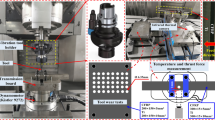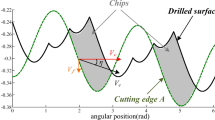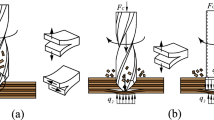Abstract
In low-frequency vibration-assisted drilling (LFVAD) of CFRP/Ti6Al4V stacks, owing to the different mechanical and thermal performances of the involved carbon fiber–reinforced plastic (CFRP) composite and Ti6Al4V alloy, the short tool life of commonly used carbide (WC) tools and rapidly deteriorated machining quality are the major problems. This paper aims to explore whether the polycrystalline diamond (PCD) tool can achieve a competitive effect on drilling CFRP/Ti6Al4V stacks compared with previous CFRP drilling studies. To avoid the frequent occurrence of chisel edge fracture in LFVAD of Ti6Al4V alloy, a model of plowing behavior is established and parametric experiments based on it are performed with both PCD and WC drills. It is found that the periodically dynamic force is the major factor causing the chisel edge fracture of the PCD drill, which can be alleviated by reducing the feed rate. Besides, by using PCD drills instead of WC drills in Ti6Al4V drilling, the exit burr height, drilling diameter deviation, and surface roughness value are reduced under each given parameter. Finally, PCD and WC drill bits are used to perform a wear test on the CFRP/Ti6Al4Vstacks under optimized parameters. The PCD drill achieves superior performance, including lower wear rate, better hole quality, and higher consistency. The experiments discussed in this paper provide some suggestions for selecting tools and cutting parameters when drilling CFRP/Ti6Al4V stacks.



















Similar content being viewed by others
Data availability
The datasets used or analyzed during the current study are available from the corresponding author on reasonable request.
Code availability
Not applicable.
References
An Q, Dang J, Li J, Wang C, Chen M (2020) Investigation on the cutting responses of CFRP/Ti stacks: with special emphasis on the effects of drilling sequences. Compos Struct 253:112794. https://doi.org/10.1016/j.compstruct.2020.112794
An Q, Chen J, Ming W, Chen M (2021) Machining of SiC ceramic matrix composites: a review. Chin J Aeronaut 34:540–567. https://doi.org/10.1016/j.cja.2020.08.001
Xu J, Mkaddem A, El Mansori M (2016) Recent advances in drilling hybrid FRP/Ti composite: a state-of-the-art review. Compos Struct 135:316–338. https://doi.org/10.1016/j.compstruct.2015.09.028
Wang X, Kwon PY, Sturtevant C, Kim DD, Lantrip J (2014) Comparative tool wear study based on drilling experiments on CFRp/Ti stack and its individual layers. Wear 317:265–276. https://doi.org/10.1016/j.wear.2014.05.007
Zitoune R, Krishnaraj V, Sofiane Almabouacif B, Collombet F, Sima M, Jolin A (2012) Influence of machining parameters and new nano-coated tool on drilling performance of CFRP/aluminium sandwich. Compos Part B 43:1480–1488. https://doi.org/10.1016/j.compositesb.2011.08.054
Xu J, El Mansori M (2017) Wear characteristics of polycrystalline diamond tools in orthogonal cutting of CFRP/Ti stacks. Wear 376-377:91–106. https://doi.org/10.1016/j.wear.2016.11.038
Kaya E, Kaya İ (2020) Tool wear progression of PCD and PCBN cutting tools in high speed machining of NiTi shape memory alloy under various cutting speeds. Diam Relat Mater 105:107810. https://doi.org/10.1016/j.diamond.2020.107810
Lindvall R, Lenrick F, Persson H, M ' Saoubi R, Ståhl J, Bushlya V (2020) Performance and wear mechanisms of PCD and pcBN cutting tools during machining titanium alloy Ti6Al4V. Wear 454-455:203329. https://doi.org/10.1016/j.wear.2020.203329
Lazoglu I, Poulachon G, Ramirez C, Akmal M, Marcon B, Rossi F, Outeiro JC, Krebs M (2017) Thermal analysis in Ti-6Al-4V drilling. CIRP Ann 66:105–108. https://doi.org/10.1016/j.cirp.2017.04.020
Da Silva RB, Machado ÁR, Ezugwu EO, Bonney J, Sales WF (2013) Tool life and wear mechanisms in high speed machining of Ti–6Al–4V alloy with PCD tools under various coolant pressures. J Mater Process Technol 213:1459–1464. https://doi.org/10.1016/j.jmatprotec.2013.03.008
Oosthuizen GA, Akdogan G, Treurnicht N (2011) The performance of PCD tools in high-speed milling of Ti6Al4V. Int J Adv Manuf Technol 52:929–935. https://doi.org/10.1007/s00170-010-2804-2
Park K, Beal A, Kim DD, Kwon P, Lantrip J (2011) Tool wear in drilling of composite/titanium stacks using carbide and polycrystalline diamond tools. Wear 271:2826–2835. https://doi.org/10.1016/j.wear.2011.05.038
Okamura K, Sasahara H, Segawa T, Tsutsumi M (2006) Low-frequency vibration drilling of titanium alloy. JSME Int J Ser C Mech Syst Mach Elem Manuf 49:76–82. https://doi.org/10.1299/jsmec.49.76
Pecat O, Brinksmeier E (2014) Tool wear analyses in low frequency vibration assisted drilling of CFRP/Ti6Al4V Stack Material. Procedia CIRP 14:142–147. https://doi.org/10.1016/j.procir.2014.03.050
Brehl DE, Dow TA (2008) Review of vibration-assisted machining. Precis Eng 32:153–172. https://doi.org/10.1016/j.precisioneng.2007.08.003
Kuo C, Li Z, Wang C (2017) Multi-objective optimisation in vibration-assisted drilling of CFRP/Al stacks. Compos Struct 173:196–209. https://doi.org/10.1016/j.compstruct.2017.04.026
Li S, Zhang D, Geng D, Shao Z, Tang H (2019) Modeling and drilling parameters optimization on burr height using harmony search algorithm in low-frequency vibration-assisted drilling. Int J Adv Manuf Technol 101:2313–2325. https://doi.org/10.1007/s00170-018-2997-3
Yang H, Chen Y, Xu J, Ladonne M, Lonfier J, Fu Y (2019) Tool wear mechanism in low-frequency vibration–assisted drilling of CFRP/Ti stacks and its individual layer. Int J Adv Manuf Technol 104:2539–2551. https://doi.org/10.1007/s00170-019-03910-z
Xu J, Ji M, Paulo Davim J, Chen M, El Mansori M, Krishnaraj V (2020) Comparative study of minimum quantity lubrication and dry drilling of CFRP/titanium stacks using TiAlN and diamond coated drills. Compos Struct 234:111727. https://doi.org/10.1016/j.compstruct.2019.111727
Zeilmann RP, Weingaertner WL (2006) Analysis of temperature during drilling of Ti6Al4V with minimal quantity of lubricant. J Mater Process Technol 179:124–127. https://doi.org/10.1016/j.jmatprotec.2006.03.077
Gupta MK, Sood PK, Sharma VS (2016) Machining parameters optimization of titanium alloy using response surface methodology and particle swarm optimization under minimum-quantity lubrication environment. Mater Manuf Process 31:1671–1682. https://doi.org/10.1080/10426914.2015.1117632
Wang X, Li C, Zhang Y, Ding W, Yang M, Gao T, Cao H, Xu X, Wang D, Said Z, Debnath S, Jamil M, Ali HM (2020) Vegetable oil-based nanofluid minimum quantity lubrication turning: academic review and perspectives. J Manuf Process 59:76–97. https://doi.org/10.1016/j.jmapro.2020.09.044
Yang M, Li C, Zhang Y, Jia D, Li R, Hou Y, Cao H (2019) Effect of friction coefficient on chip thickness models in ductile-regime grinding of zirconia ceramics. Int J Adv Manuf Technol 102:2617–2632. https://doi.org/10.1007/s00170-019-03367-0
Davim JP (2009) Machining composites materials. Wiley, London
Fukuhara M, Sanpei A (1993) Elastic moduli and internal frictions of Inconel 718 and Ti-6Al-4V as a function of temperature. J Mater Sci Lett 12:1122–1124. https://doi.org/10.1007/BF00420541
Li G, Rahim MZ, Pan W, Wen C, Ding S (2020) The manufacturing and the application of polycrystalline diamond tools – a comprehensive review. J Manuf Process 56:400–416. https://doi.org/10.1016/j.jmapro.2020.05.010
Li A, Zhao J, Wang D, Zhao J, Dong Y (2013) Failure mechanisms of a PCD tool in high-speed face milling of Ti–6Al–4V alloy. Int J Adv Manuf Technol 67:1959–1966. https://doi.org/10.1007/s00170-012-4622-1
McNamara D, Carolan D, Alveen P, Murphy N, Ivanković A (2016) Effect of loading rate on the fracture toughness and failure mechanisms of polycrystalline diamond (PCD). Int J Refract Met Hard Mater 60:1–10. https://doi.org/10.1016/j.ijrmhm.2016.06.011
Funding
This work was financially supported by the National Natural Science Foundation of China (No. 51875284).
Author information
Authors and Affiliations
Contributions
Chaoren Yan and Yan Chen contributed to the conception of the study.
Chaoren Yan and Yijia Chen performed the experiment.
Haojun Yang and Ning Qian contributed significantly to analysis and manuscript preparation.
Chaoren Yan performed the data analyses and wrote the manuscript.
Yan Chen and Haojun Yang helped perform the analysis with constructive discussions.
Corresponding author
Ethics declarations
Ethics approval
Not applicable.
Consent to participate
Not applicable.
Consent for publication
Not applicable.
Competing interests
The authors declare that they have no competing interests.
Additional information
Publisher’s note
Springer Nature remains neutral with regard to jurisdictional claims in published maps and institutional affiliations.
Rights and permissions
About this article
Cite this article
Yan, C., Chen, Y., Yang, H. et al. Machining performance of PCD drill in low-frequency vibration-assisted drilling of CFRP/Ti6Al4V stack: with special emphasis on the plowing behavior. Int J Adv Manuf Technol 116, 2269–2283 (2021). https://doi.org/10.1007/s00170-021-07603-4
Received:
Accepted:
Published:
Issue Date:
DOI: https://doi.org/10.1007/s00170-021-07603-4




